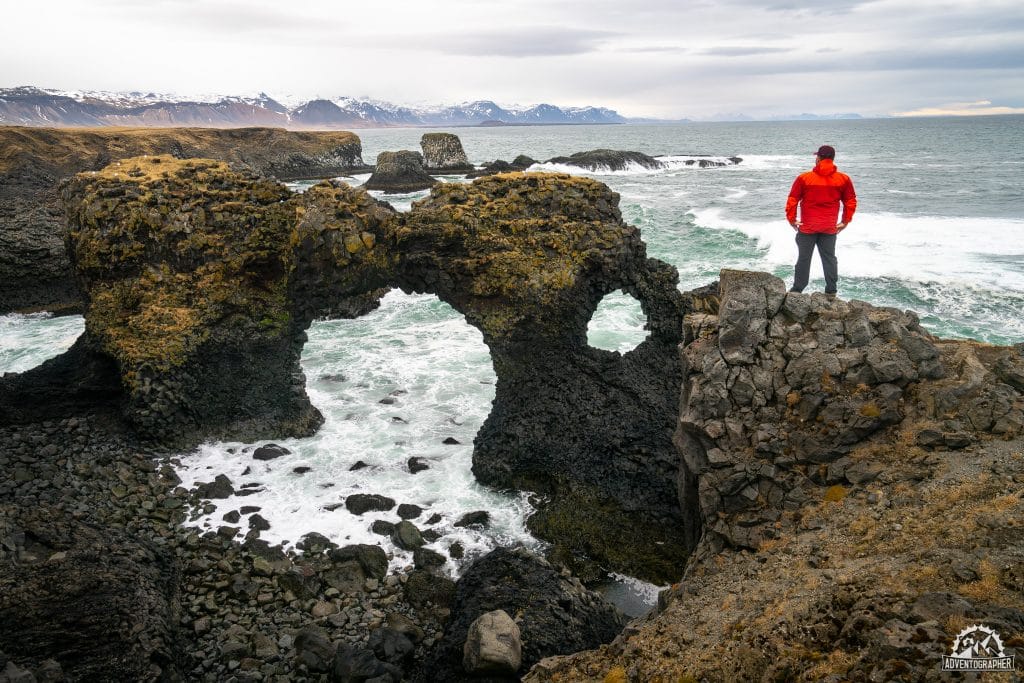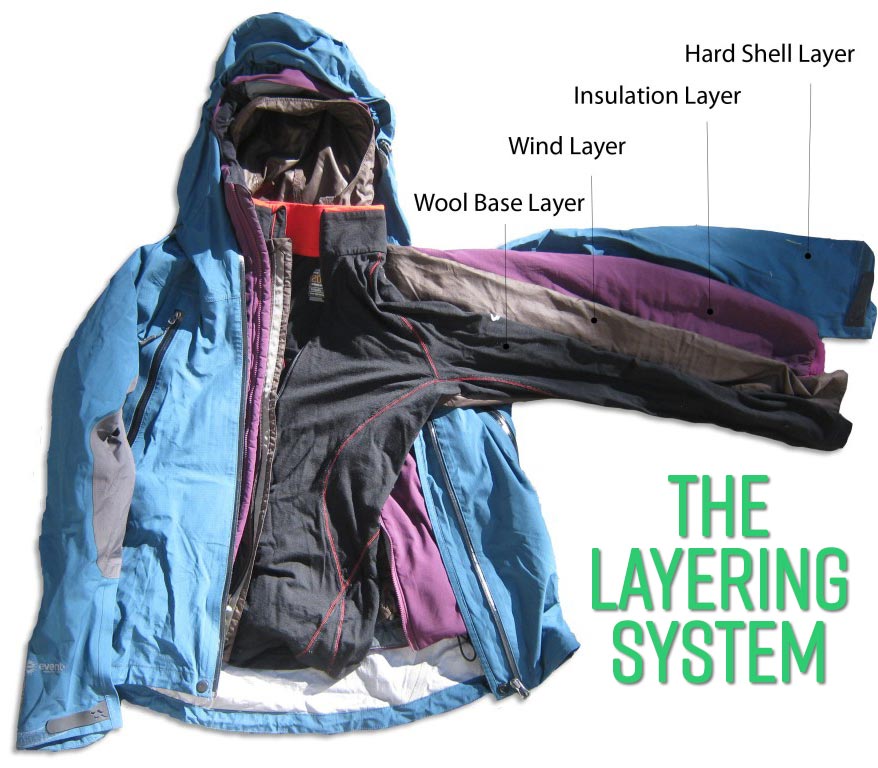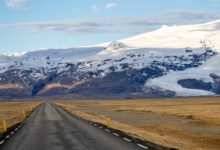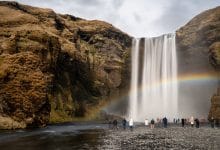- Iceland's Unpredictable Weather
- The Layering System - Dress Like A Pro
- What to Wear in Iceland by Season
Iceland, it’s is like nowhere you’ve ever traveled before.From glaciers to volcanoes and hot springs to icebergs it’s a land of extremes. There’s no wonder then, since returning from the small island nation why one of the most common questions I’ve been asked is what to wear in Iceland or what to pack for Iceland.
Iceland’s weather is notoriously variable. Icelander’s say “if you dont like the weather wait five minutes”. Even long time locals, used to the weird weather, are occasionally caught off guard! Iceland’s subarctic climate is heavily affected by the islands offshore currents. Winters drag on and summers are short and bittersweet

As a visitor to Iceland you shouldn’t be surprised to get rain, hail, sleet, snow and wind all in the same day. Of course, this makes deciding what to wear in Iceland and packing for your trip incredibly difficult! Summer isn’t always summer here and winter is actually much more mild than most would think. You’ll likely need to pack everything from shorts and bikini’s to wool and winter coats!
Read Also: 9 Secret Hotsprings in Iceland
So what should you pack for your Iceland vacation? Honestly the answer I’ll give you is the same for every season of the year: Layers!
Here we’ll draw from our own experience visiting Iceland in the spring and having to deal with the ‘interesting’ weather to help you decide what you need to take, but let it be known, I’m no fashionista, you’ll get function over fashion on this blog!
How to stay comfortable: Layering
One moment you’ll be enjoying the landscape in the sun, suddenly it will cloud over and start to rain and by the time you’ve retrieved your jacket it’s back to sunshine. Sometimes you laugh, sometimes you cry but with such unpredictable weather to deal with the only choice of what to wear in Iceland becomes layers.
Compounded by space restrictions in your rental vehicle if you’re road-tripping around Iceland—and you should be—or weight restrictions for your flights choosing what to wear in Iceland and what to pack becomes even more challenging.
It might be tempting to toss a big heavy parka into your bag to protect you from the cold of Iceland’s winter. In actual fact, the most effective way to keep comfortable is to wear multiple layers. Dressing in layers, or the “layering system” as its known allows you to quickly pile on or remove items as needed to stay comfortable. Individual layers are small, lightweight and easy to pack letting you stay ready for whatever the weather will throw at you.

Base Layer
The base layer is the first layer of your clothing system. It sits next you your skin and has two main functions; to wick moisture away from your skin and to help regulate your body temperature. Wicking moisture or sweat away from your skin prevents it from drawing heat away from your core and is the most important thing to look for in a base layer.
Cotton and cotton blend fabrics are a big no-no as a base layer, there’s a reason the phrase “cotton kills” is commonplace among outdoor enthusiasts. It absorbs & holds moisture from your skin making you feel cold and doesn’t dry quickly. Wool, silk or polypropylene inner layers hold body heat & wick better than cotton does.
Wind/Mid Layer
The purpose of the mid-layer is to capture warmth by trapping air, plain and simple. Sometimes referred to as a wind layer the mid layer’s job it to trap head missed by your base layer and prevent it from being stripped away by air movement.
Typically a mid layer is a quality fleece, soft-shell or thick wool garment. On of my favorite mid-layers, the Patagonia R1 jacket is a waffle weave fleece that provides great warmth but also breaths amazingly well ensuring you dont overheat.
Leading outdoor brands like Patagonia, Arcteryx, Rab and others all make excellent options. As the weather gets cooler look for thicker & warmer mid-layers for your system!
Insulation Layer
The optional insulation layer is something I reserve for the coldest of travels or my winter camping trips in the mountains when I’m expecting consistent below 0°C temperatures. An insulation layer, either synthetic or down, add extra warmth and loft to your system. Size it to fit over your other layers and under your outer shell. These layers pack down to an inconsequential size and weigh next to nothing.
I prefer a light or mid weight down jacket (with a hood in the coolest of temps) as my insulation choice. The appropriately named Mountain Hardwear Ghost Whisperer jacket is lightweight, water repellent and my first choice if I’m headed into the mountains or abroad. When the weather is more temperate I’ll regularly leave my Mid layer home instead relying on an insulation layer or vice versa. You can even go so far as to get a Travel jacket with hidden pockets!
Outer Shell Layer
I’m a huge believer in buying the right tool for the job. Along with that I was always taught to “buy it nice or buy it twice”. If you can afford it a Quality Gore-Tex™ fabric shell is the way to go. There’s no getting around the fact that these garments are incredibly expensive, but it holds true that you get what you pay for. When cared for these jackets will last you a lifetime! If it can keep me dry on Canada’s We
st Coast it can keep you dry anywhere.
Other manufacturers have their own lines of waterproof but breathable fabrics too. Dont shy away from them simply because they aren’t “Gore-Tex” but I would Advise you to do some reading about the jacket you’re thinking of picking up! I love my Arcteryx Beta AR jacket.
Lower body
So layering essentially takes care of our upper body but what about your lower half? It’s quite possible to extend your layering system to the lower body, and in the outdoors while climbing our exploring the back country I typically do. For Iceland however, dressing like this is going to be overkill!
For travel in general my recommendation is to wear lightweight, fast drying pants or shorts. Not only do these garments breath well and stretch a bit when needed they’re generally just comfortable to wear. Add in the fact that the good ones dont hold moisture, dry quickly and dont lock in smells like some denims and they’ll always have a spot in my travel backpack! I love my Outdoor Research Voodoo pants.
See Also: The Best Backpacks for Travellers – Buy it Right
A pair of waterproof/rain pants is nice to have if you’re planning to get up close and personal with Iceland’s amazing waterfalls. Without them the spray will have you soaked in minutes. Thought that’s not a problem if you brought quick dry pants as suggested above!
Layering Video
Accessories For All Seasons
No matter what time of year you visit Iceland you’ll want to think about packing the following:
- Gloves – Even mid summer when the wind picks up it’s got a bite to it. A pair of decent gloves helps to keep you comfortable and enjoying what you came to Iceland to see, the outdoors. A good pair of wool gloves will keep you warm even when damp!
- Hat – You need to protect your head! be it from the wind, or sun you’ll be happy to have something on your head.
- Waterproof Hiking Boot/Shoes – Iceland is wet, that’s all there is too it. Whether its snow, rain, walking up rivers or simply boggy landscapes you’re bound to get your feet wet. Unless of course, you bring good waterproof hiking boots or shoes. Comfort should be your #1 concern, to see the best spots in Iceland you’ll be doing a lot of walking!
- Swimwear – Did you ever even visit Iceland if you didn’t soak in of of its epic hot springs? The hotsprings in Iceland are an important part of the experience! While you could bath au-natural in some most are popular enough that you should have your shorts or bikini with you!
Read More: Visiting Iceland’s Blue Lagoon – Everything you NEED to know!
The Seasons:
What to Wear in Iceland in Spring
Teasing warm days are sprinkled with frigid wintry ones as the temperatures slowly warm through the Icelandic spring. Averaging 5°C March sees the most precipitation, which then tapers off until the fall. My experience in Iceland lies here, in the springtime. We had gorgeous sun, howling wind, torrential rain and even a whiteout blizzard during our trip. I think it’s safe to say that spring may be the most unpredictable of all the seasons in Iceland. Because of this is can be incredibly difficult to cover all your bases when packing for Iceland.
When visiting Iceland in the spring consider the following items in addition to your layers:
- Pack Multiple Pairs of Shoes – Unless you buy the best of the best waterproof shoes you’ll end up with wet feet. Bring a secondary change of shoes and plenty of extra socks to keep your feet happy!
- Leave the Umbrella at Home – Iceland’s unpredictable weather and strong winds make using an umbrella a practice in patience—if you can manage to make it happen at all. You’ll be much better off packing a good waterproof jacket to keep dry.
What to Wear in Iceland in Summer
Summer in Iceland isn’t exactly the summer you’re probably used to… POP, thats the sound of me bursting your bubble. Traveling during the most temperate season in Iceland—averaging 10-15°C—doesn’t come without its challenges. Even weathered veterans of the island wont try to predict the weather here. Being ready for anything is the best advice we can give. Make sure you bring:
- Sleep Mask – You dont really wear it, but, it deserves a place on this list! I dont know about you but I have a small case of FOMO. If its light outside I feel like I should be out seeing and experiencing things. The midnight sun and 20+ hour days during Iceland’s summer will have you exhausted in no time though. Being able to lay down and actually get some rest is crucial. You cant count on having blackout curtains outside of Reykjavik. A quality sleep mask can help make all the difference!
- Sun Protection – While the summers dont get overly hot you’ll still burn easily. Bring your sunscreen, hat and sunglasses with you everywhere!
What to Wear in Iceland in Fall
Like Spring, Fall in Iceland is a time of change. Warm days start to give way to cool nights and the rains—though infrequent—return. The northern lights make their return as the days get shorter and most of the tours and activities still available for travellers. Best of all having left behind the crazy tourist rush of summer, flights, accommodations and even food will be cheaper.
Packing for Iceland in the fall is pretty well exactly like Spring above! Check it out!
What to Wear in Iceland in Winter
Thanks to the Gulf Stream Iceland’s winters are quite mild. Averaging a warm 0°C on the south coast and only -10°C in the highlands it’s one of the warmer countries that crosses the arctic circle. With short days and long nights, you’re in for some cold but likely also clear conditions—although not without wind. With any luck, as if compensation for the short days, you’ll experience the magic of the aurora in the dark skies overhead. Taking a northern lights tour should be on your list!
Traveling to Iceland in the winter you’ll want to bring your layers and also consider:
- Cold Weather Boots/Footwear – You’re not going to need -40C rated boots by any means but an insulated & waterproof boot will make you happy as you’re exploring the countryside, walking through snowdrifts and
- A Buff or Scarf – A buff or good scarf can be a life saver when the wind picks up. I opt for a buff, its simple and definitely not a fashion statement but being able to pull it up over your nose and mouth in the most extreme situations makes it a worthy choice.
- Toque/Beanie Hat – A knit hat is a staple of winter weather travel. Bring something that’s comfortable as you’ll be wearing it often! For extra style points make sure it’s got a Pompom on top!
- Traction Aids – When visiting many of the ‘must-see’ sights during the winter you’ll find slippery, icy conditions! Spray from waterfalls freezes on the trails rendering them almost unusable. Before you end up on your ass consider bringing traction aids with you! These mini-spikes will strap onto your shoes or boots and help keep you upright when the going gets tough! YackTrax are a popular brand.
The Take Away
Iceland’s unpredictable weather patterns make packing difficult thats for sure. No matter what you decide to wear in Iceland make sure that you’ll be warm and dry! I hope this post has helped you refine your packing list and answered the question of “what to wear in Iceland”. After getting your laying system worked out packing for adventures will never be the same!
Have you been to Iceland? Think we missed something? Drop a comment below or touch base on our social media channels! We’d love to hear from you!








I wonder when will I be able to take myself to Iceland. I keep visualizing myself there, I am constantly amazed whenever I see pictures and blog posts like this that show how beautiful it is. But I know that it’s cold in there and I don’t do well in cold. At least now I know how to layer thanks to this post. I’d probably gain weight with all those clothes I need to layer on haha…
Its not as cold as you think but yes, you’ll definitely be appearing a bit bulky with the layers you need to be comfortable 🙂 Thanks for stopping in!